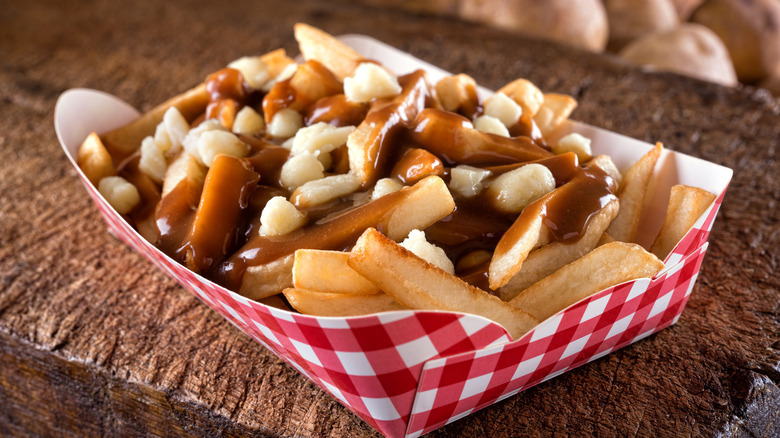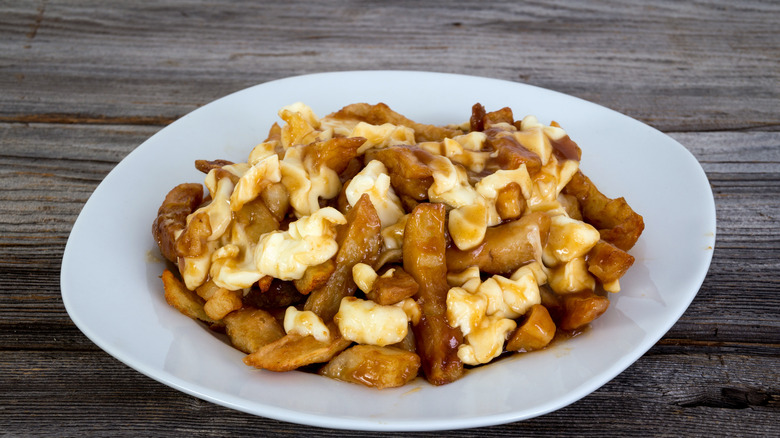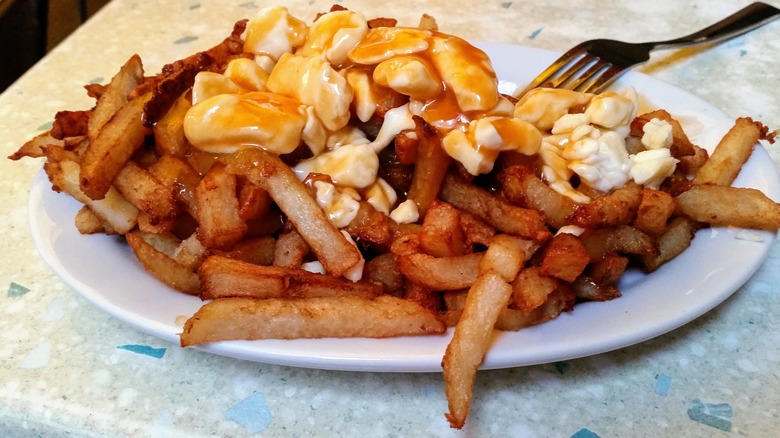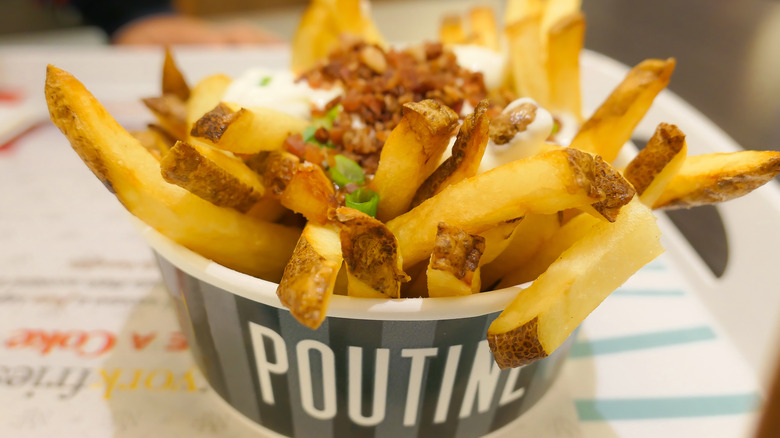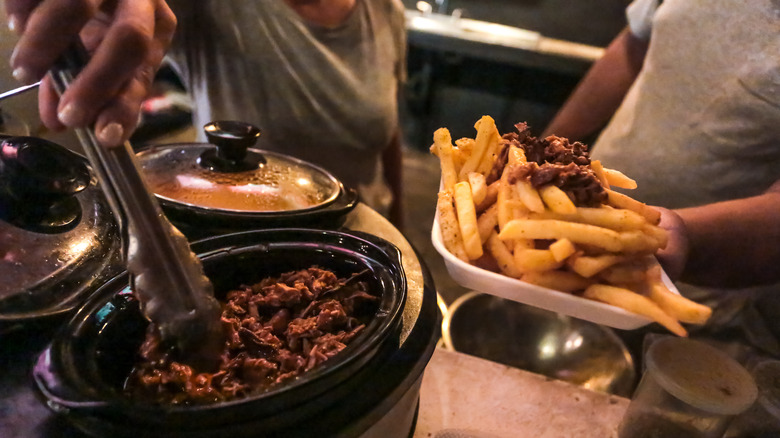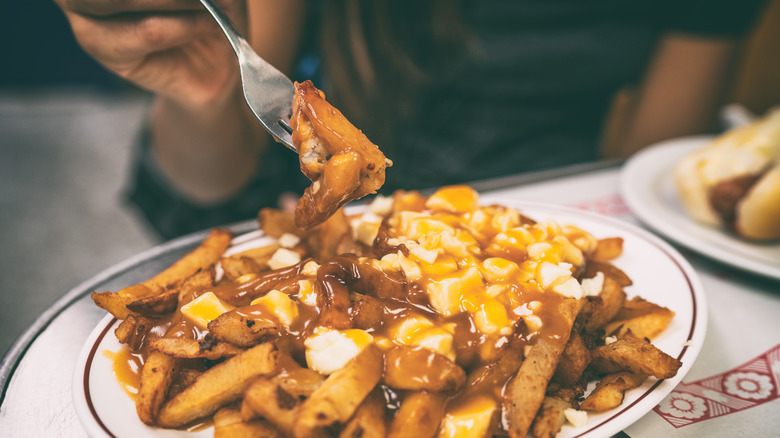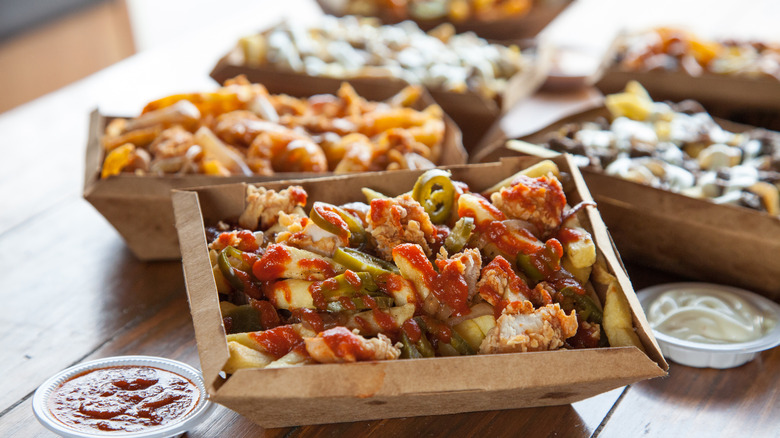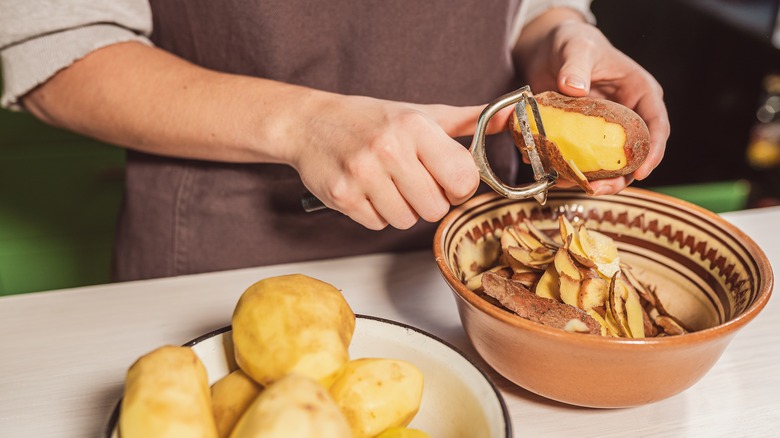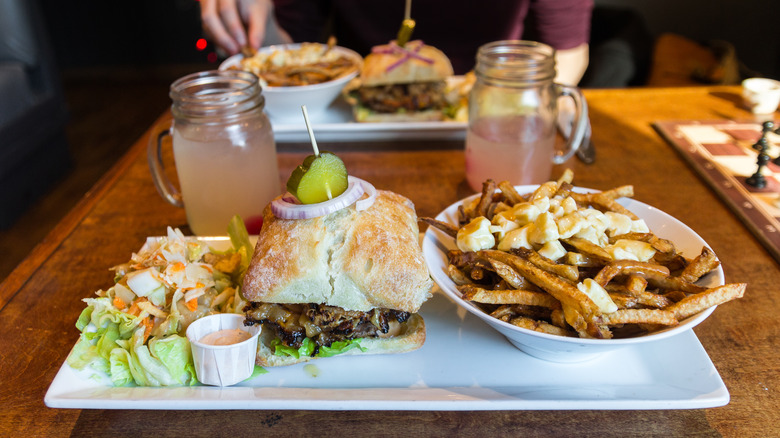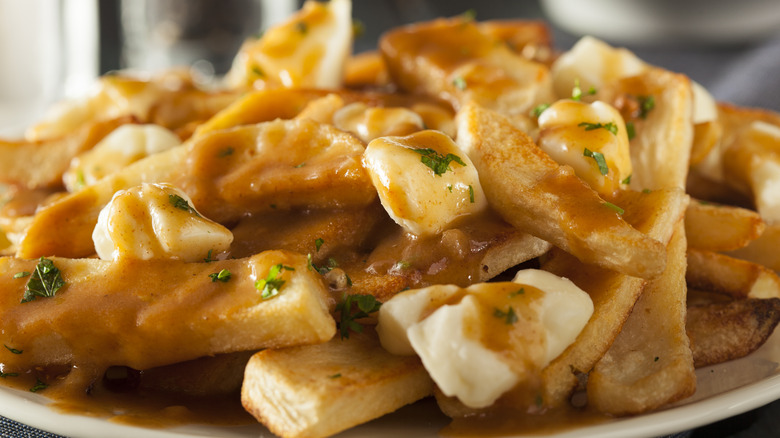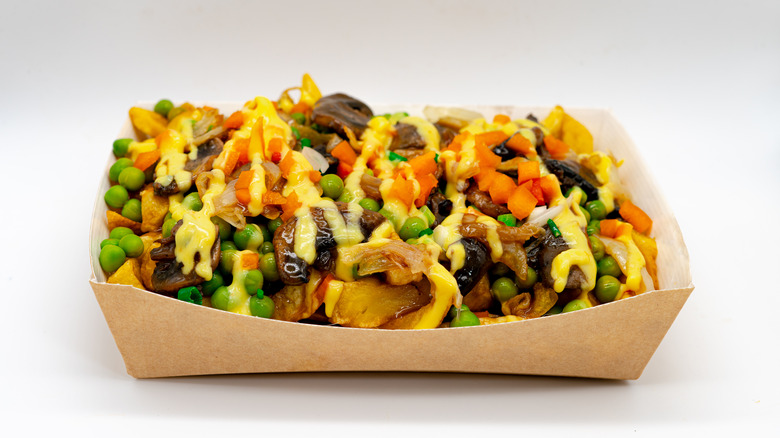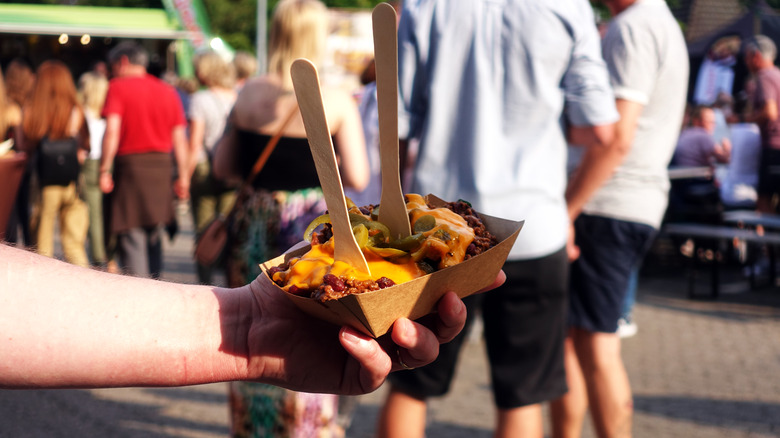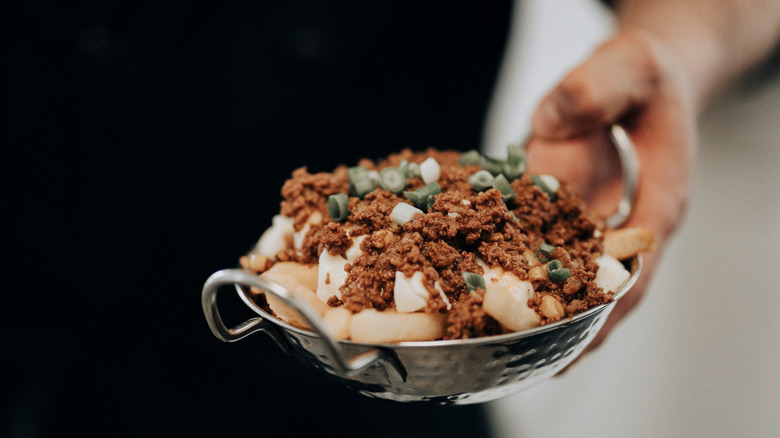A Beginner's Guide To All Things Poutine
Have you heard of poutine? Perhaps you've even tried it. But, do you really understand exactly what poutine is, what ingredients are used to make it, what it tastes like, or why it is even called poutine? If you have these questions — and more — about anything and everything that has to do with poutine, you'll want to keep reading.
In the next few sections, we'll examine the origins of this dish, dive into whether you can make it at home and the ingredients you'll need if you want to try, some of the best places to try it, and even look at two special events related to the popular dish. Whether you've had poutine a few times and want to learn more about it before indulging again, or only know enough to understand that poutine is some sort of food item, don't miss out on learning more about this dish.
What is poutine?
Let's start with the basics: what is poutine? Poutine is a Canadian dish that is made with french fries, gravy and cheese curds. The gravy is poured over the fries and then the whole plate is topped with cheese curds. If your mouth is watering a bit just thinking about how combining these three ingredients will taste, you're not alone. However, if you don't live in Canada, you may have a more difficult time finding poutine, as it is most common there. If you're lucky enough to live in Canada, particularly Quebec, then you should have no difficulty finding several different poutines to try. If you don't live in Canada, but are planning to visit, be sure to add trying poutine to your list of must-do's.
Because of its richer ingredients, poutine is by no means a healthy food. It is, however, seen as a comfort food. Who wouldn't want to cuddle up under a blanket on a cold day (of which there are many in Canada) and enjoy a serving of warm and delicious poutine?
What is the history of poutine?
So, now that you know that poutine is a scrumptious combination of french fries, gravy, and cheese curds, you might be wondering how in the world such a dish was even thought of. It is believed that the dish was first developed by a restaurant owner in Quebec, Fernand Lachance. According to the stories about the dish, in 1957 one of Lachance's regulars, Eddy Lainesse, came in to enjoy some french fries. However, once he noticed Lachance's display of fresh cheese curds sitting on the counter, he decided that they would taste good with the french fries. Lainesse decided to put in the special request for the dish, Lachance fulfilled his request, and served him french fries topped with cheese curds in a waxed paper bag.
After combining the french fries and the cheese curds for Lainesse (and likely seeing how much he enjoyed their flavors together), Lachance decided to add the newly created dish to his menu — it cost just 40 cents. Later, he decided to offer customers the option to add gravy to the fries and cheese curds to help everything stay warmer. This option was available for an additional 10 cents, and poutine as we know it today was officially born.
The dish took off and quickly gained popularity, even being added to the menu at many other restaurants, even Canadian Burger Kings in 1992. Today, poutine is most commonly served with beef gravy, but the original gravy added to the dish at Lachance's restaurant was a blend of ketchup, brown sugar, and Worcestershire sauce.
Why is it called poutine?
The name poutine — which is pronounced poo-teen — has an interesting story too. As shared above, the first poutine was created by restaurant owner Fernand Lachance after it was requested by Eddy Lainesse, a regular at the restaurant. As you can imagine, the thought of eating french fries and cheese curds together (out of a paper bag as Lachance served them) sounds like it is likely to make a mess. In fact, this is precisely what Lachance said when the dish was first requested. His response to Eddy Lainesse asking for the fries with cheese curds was, "ça va te faire une maudite poutine." This translates to, "that will make a damned mess."
When you consider that Lachance added gravy to the already messy combination of fries and cheese curds, poutine seems like a rather fitting name. While this is one theory behind the origins of the name "poutine," it isn't settled. Others believe that the name poutine was derived from combining potin and poutitè, two French words which mean pâté and potato ragout, respectively.
What ingredients are used to make poutine?
Poutine is as easy as french fries, gravy, and cheese curds. However, you'll want to put some thought into each component of the dish for the best results. First, you don't want to just use any fries. If you think about the prospect of trying to pick up a really thin-cut french fry loaded with thick gravy and heavy cheese curds, you can probably envision what a messy disaster it could be. So, you'll want to find thicker-cut french fries for your poutine creations.
For the gravy, most traditional poutine recipes are served with beef gravy. However, you could use chicken, pork, or any other type of gravy or sauce when preparing yours. As always, you'll have the option to make everything from scratch or purchase the necessary components from the grocery store, depending on how much time and effort you want to put into it.
You're not alone If you haven't heard of cheese curds — the third key ingredient in poutine. They're more popular in the Midwest and parts of Canada than they are in many other parts of the United States. Cheese curds are just small chunks of curdled milk. During the cheese-making process, the curds form when the cream from the milk separates from the thinner whey. Their texture is different from that of other types of cheese in that they are airier and a bit rubbery. They will even squeak when bitten into. Cheese curds are milder than strong cheese with a flavor similar to that of cheddar cheese.
What does poutine taste like?
Now, for the all important question: what exactly does poutine taste like? In one word, poutine is delicious. To go into more detail about what you can expect, think about the combination of the flavors between the three key ingredients used to make a classic poutine: french fries, cheese curds, and beef gravy. While the fries covered in the gravy will have a softer texture, those that are on the outside of the dish and not under the gravy should still be nice and crispy, delivering a little crunch as you enjoy the poutine. The beef gravy that is used for more traditional poutine recipes is quite rich, imparting a meaty taste to the dish.
As for the cheese curds, they help pull everything together and make the gravy mixture a bit creamier. As noted above, good cheese curds will also squeak a bit when you bite into them. While this doesn't affect the taste of poutine, it can add to the overall enjoyment you'll experience when you eat it.
Are there different variations of poutine?
There are actually several variations of poutine. As you can probably imagine, with its basic recipe, there are lots of ways that you can experiment with adding different ingredients. And, that's precisely what different chefs and restaurant owners have done. The possibilities are nearly endless, but there are some that are more common than others. One example is veggie poutine. Rather than the french fry base and gravy topping of traditional poutine, this vegetarian variation features a bed of vegetables topped with mushroom sauce. You may also see Italian poutine. Instead of the gravy topping, spaghetti sauce is used to top the fries for this variation.
In some areas, particularly where cheese curds aren't as common or well-known, shredded cheddar or mozzarella cheese may be used to top the gravy and fries. If you're making your own poutine, anything goes. Consider piling on additional toppings, such as ham, bacon, sliced beef, chopped chicken, shredded pork, mushrooms, or onions. You could also swap out the french fries for tater tots, roasted potatoes, or any other base you like. Of course, you could also ditch the gravy in favor of a sauce with a flavor you prefer. The possibilities really are endless.
Can you make poutine at home?
Now that you know more about the ingredients you'll need to make poutine, as well as some of the different variations of this messy, yet scrumptious, Canadian dish, you might want to know whether it is possible to make it at home yourself. Fortunately, the answer to this question is a definite yes. Poutine is a rather simple recipe to make. To make the traditional version, you'll only need the three ingredients of french fries, gravy, and cheese curds. French fries and gravy are easy to grab at the grocery store (or to make your own with just a few ingredients). Finding cheese curds could be a bit more challenging, depending on where you live. However, with their increasing popularity, many grocery stores carry them now. If you aren't able to find cheese curds, don't fret. You could still make your own poutine and use cottage cheese, ricotta cheese, or your favorite type of shredded cheese in place of the cheese curds.
When making your own homemade poutine, you also have control over the specific ratio of ingredients and can add your own twist to the recipe. If you like the way the gravy flavors it, but find that most restaurants pour too much over the fries, opt to use a bit less when you make your original recipe. You could also consider seasoning your french fries with other ingredients, such as rosemary, parmesan, or garlic, based on your preferences. If you're feeling really adventurous, you might even decide to recreate the giant poutine tornado developed by a Canadian cooking show.
What can you serve with poutine?
If you're thinking about making poutine to serve to your family or a group of friends, you might be stumped about what to serve with it. Is poutine a side dish? Is it designed to be a main course? The answer to both of these questions is yes. Poutine can be either a side dish or a main dish, depending on how it is served, how much you want to eat, and other variables.
If you're thinking of making poutine to share with others, your first decision should be whether you want it to be the star of your meal and the main course or a side dish to another entrée you'll prepare. If you opt to serve poutine as a main course, consider dishing out larger portions for you and your guests. You could also consider one of the poutine variations that adds meat or other heartier toppings over the gravy and cheese curds. When served as a side dish, a smaller portion should be sufficient. Depending on what you're serving it with, you might decide to go lighter with the gravy and cheese curds to avoid serving too heavy of a meal.
Once you've made the decision about whether poutine will be the main course or a side dish, you can choose the appropriate accompaniments. If poutine will be your main course, consider pairing it with a side salad, some vegetables, or other lighter and healthier sides. If you want to serve it as a side, consider serving it alongside a sandwich, a roast, some steaks, or other meaty dishes.
Where can you get poutine?
As we've already shared, poutine was developed in Canada. For this reason, finding poutine if you're in Canada should be a rather simple endeavor. It took a while for poutine to be available outside of Canada, but today it is much more well-known and easier to find throughout the United States. If you can't find poutine on any local menus in your area, there are a few restaurants across the United States that are known for serving delectable poutine. Some of these include Mile End Deli in New York City, New York, Banger's Sausage House & Beer Garden in Austin, Texas, and Brooklyn Street Local in Detroit, Michigan.
While it is gaining popularity in other places, poutine is still much more common in Canada than other parts of the world. The dish is seen as an integral part of the country's cuisine. If you are unable to find poutine near you, and don't have the time, budget, or desire to travel to Canada, remember that you can always try making your own.
Does poutine have any allergens?
Some people may be hesitant to try a new dish out of a fear that it contains an ingredient that they are allergic to. So, does poutine have any allergens that you should know about? There are so many potential allergens that affect different people, so it is difficult to find a food that would be considered allergen-free for everyone, and poutine is no exception. Depending on your specific allergies, some of its components could be problematic for you.
Some frozen french fries, for example, are made using wheat, dairy, or soy. If you are allergic to any of these ingredients, your best bet may be to make your own french fries so that you can control what is — and isn't — added to them. Similarly, gravy can also have allergens, depending on how it is prepared. These may include dairy products, soy, or wheat products, which are often added to thicken gravy in restaurants or to powdered or canned gravy that you can purchase at the grocery store.
Obviously, if you are allergic to dairy products, you shouldn't be eating cheese curds. However, you could consider making your own dairy-free poutine recipe using a cheese alternative. Consider nutritional yeast or shredded "cheeses" made from pea proteins. With a little creativity, you can make a homemade poutine recipe that will be safe based on your specific dietary requirements.
Can you make vegan poutine?
If you are vegan, then you may have already ruled out the possibility of enjoying poutine. With its beef gravy and cheese curds, two of the three ingredients, it isn't exactly a vegan-friendly dish. However, that doesn't mean that you can make some alterations to the recipe to make it into something that you can enjoy.
Let's start with the gravy. You do not have to use beef gravy to make a delicious poutine. You can substitute your favorite vegan-friendly sauce. Consider mushroom or onion gravy, tzatziki, hummus, creamed avocado, or any other sauces or gravies you enjoy. For the cheese curds, look for vegan-friendly cheese substitutes, such as a homemade cashew or almond "cheese" or a store-bought option such as nutritional-yeast of Daiya vegan cheese.
While making these modifications to a poutine recipe won't produce a dish that tastes exactly like the original, you can play around until you find something that you really like. There really are several different options and combinations to experiment with, and experimenting can be half of the fun. A few combinations you might want to try include topping the french fries with mushroom gravy and cashew cheese or adding a topping of creamed hummus and avocado sprinkled with nutritional yeast.
When is National Poutine Day
Poutine is kind of a big deal in Canada. As mentioned earlier, many people in the country see it as one of the most defining foods of Canada. This should be abundantly clear when you learn that there is even a day dedicated to celebrating poutine. April 11 is National Poutine Day. This special day commemorating the delectable dish was created in 2018. It is a big deal in large Canadian cities — such as Quebec, Montreal, Toronto, and Ottawa — and serves to bring Canadian citizens together to celebrate this shared aspect of their culture.
On National Poutine Day in Canada, you're likely to find several new and exciting variations of the dish to dry. Chefs like coming up with special poutine recipes to share on this special holiday. Several Canadian restaurants promote the holiday and invite customers to try their unique variations to the traditional recipe. Some offer 10, 20, or more different pairings to try.
What is La Poutine Week?
If you don't think one day is sufficient to celebrate the magnificence that is poutine, don't worry. You don't have to limit yourself to a short 24-hour celebration. Each year, around February, the city of Montreal dedicates not just one, but two weeks, to the popular dish. During this time, dubbed La Poutine Week, several restaurants in the city release their own poutine variations and compete with one another to see who has the best recipe.
There are several different awards that are up for grabs. Some of these awards are selected by everyday restaurant goes (People's Choice awards), while others are selected by a panel of judges (Judge's Choice awards).
This year's festival has passed and the results for La Poutine Week 2023 are in. There were some rather amazing creations that were selected as winners for the contest, such as La poutine Crise d'identité from La Gaspésienne 51, a unique cross between poutine and seafood lasagna, Our Prickly Dill-emma from Brazen Hall Kitchen, which combines french fries, pickles, chives, candied bacon, cheese curds, and a chipotle hollandaise gravy, and The Big Newf-owski Lobster Poutine from The Bruce Craft House, which features french fries topped with cheese curds, lobster, and shallot tarragon hollandaise sauce.
